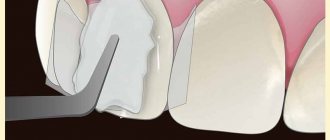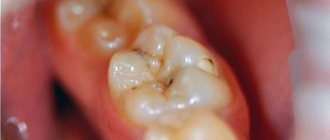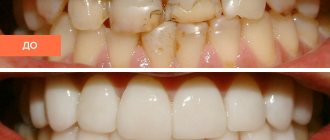Dental restoration or dental restoration is an artistic, direct and aesthetic restoration of the front teeth. Price for dental restoration in Moscow.
Each of us sooner or later faces a situation where teeth lose their aesthetic appeal. This may be due to carious tissue damage or deterioration in the quality of the old filling. In this case, dental units are completely or partially destroyed, their shape changes, and functionality deteriorates. As a result, a person loses one of the most important advantages - the ability to smile beautifully and communicate naturally with the interlocutor.
Today, the only correct solution is dental restoration. This procedure allows you to restore the functional characteristics and shape of damaged teeth using veneers or light-composite fillings.
Today, along with the term “artistic restoration of teeth,” consonant concepts (aesthetic and cosmetic restorations) are often found. However, in practice, they all have the same application and help restore the aesthetics of a damaged tooth.
In our Elident clinic, dental restoration is carried out by highly qualified specialists who master all the intricacies of this process, have the appropriate qualifications and solid experience. We carry out work of any complexity. Even if you need artistic restoration of your front teeth, you can count on an ideal result. Professional knowledge of all stages of dental restoration, an individual approach to each patient, the ability to work with modern materials and a flexible pricing policy - all this makes our services indispensable for patients and increases the chances of a successful outcome of the treatment process.
In this article we will talk about what aesthetic dental restoration is, consider the main methods and stages of its implementation, and provide detailed information on how much dental restoration costs in modern clinics in Moscow.
Free consultation
Our specialists will conduct a free consultation and select the best treatment option for you.
Sign up now! Online registration
+7 (495) 649-41-19
Content
1 What methods of dental restoration exist?
2 Stages of dental restoration
3 Dental restoration before and after photos
4 What influences the price of tooth restoration? 4.1 Complete crown correction
4.2 If half a tooth needs to be restored
4.3 Restoration of a chipped cutting edge of a front tooth
5 What are the disadvantages of artistic dental restoration?
6 Alternative to composite restoration
7 Prices for dental restoration
Indications and contraindications
Artistic restoration is resorted to in different cases:
- caries, noticeable fillings, wedge-shaped defects;
- chips, cracks, crown fractures;
- non-carious diseases: fluorosis, enamel erosion;
- minor pathologies of the bite: curvature, trema, diastema;
- different size or shape of the anterior units, abrasion of the cutting edge;
- dark enamel, stains that cannot be bleached with special means.
The list of contraindications includes an allergy to photocomposite or anesthetics, absence of adjacent elements, significant changes in occlusion, bruxism, gingivitis or periodontitis in the acute stage, the first and last trimester of pregnancy. If there is plaque or tartar, professional oral hygiene must be performed before the procedure.
What methods of dental restoration exist?
Currently, artistic restoration of teeth is carried out using the following two methods:
- Direct dental restoration : carried out using light-curing fillings. Dental restoration using composite materials, which is carried out by a specialist in therapeutic dentistry;
- Dental restoration with veneers : This procedure involves a prosthetic specialist who prepares the tooth and makes an impression. Next, the process of creating the veneer itself is carried out, which involves the use of ceramic or zirconium material. The resulting plate is glued to the outer surface of the tooth. As a rule, veneers are used when restoration of the front teeth takes place. Despite their inflated cost, they have a number of advantages.
Advantages and disadvantages
Artistic restoration, as an analogue of prosthetics, has many advantages:
- excellent aesthetics - looks natural, does not stand out in the dentition;
- minor enamel preparation;
- no nerve removal is required, as when installing some prostheses;
- painlessness of the procedure;
- complete recovery in 1 - 2 visits to the doctor;
- the price of reconstruction with photocomposites is lower than prosthetics;
- strength and durability.
Composite materials fade and darken after a few years as they absorb food coloring. However, if you take good care of your teeth and exclude foods with food dyes from your diet, especially strong black tea and coffee, your attractiveness can last up to 5 years or more.
The service life of veneers, crowns made of ceramics or metal-ceramics is several times longer, the original appearance is maintained throughout the entire period of operation, but the price is much higher.
Stages of dental restoration
Next, we will talk in detail about how aesthetic restoration of anterior teeth is performed. An example will be a situation where a patient needs to restore a front tooth with old fillings that have lost their aesthetic appeal.
So, the restoration of the front teeth includes the following sequential stages:
- Preparing teeth. At this stage, dental units are cleaned of plaque, the shade of the destroyed tooth is determined and, based on it, the color of the photopolymer filling is selected.
- Administration of anesthetics (if necessary).
- Removal of tissues affected by caries . When there is a need to replace an old filling material that has lost its aesthetic qualities, it is drilled out.
- Elimination of excessive salivation . If previously cotton swabs were used for this purpose, now they use an innovative product - cofferdam. This is a material made of latex, which has special holes for teeth. Thanks to such a latex scarf, it is possible to qualitatively isolate the oral cavity from wet breath and saliva, which ensures a more reliable process for installing photopolymer fillings. If insulated incorrectly, dental restorations made with light-curing materials can quickly lose their properties. This will create an unwanted dark line between the tooth and the filling, or cause the composite material to fall out.
- Installation of the pin . It is used if there is massive destruction of the crown and there is no nerve in the tooth itself. In this case, tooth restoration is carried out on a pin, which plays the role of a strengthening element and prevents the restoration from falling out.
- Dental restoration with composite material . In order to give the tooth a natural appearance, a special technique for applying photopolymer mass is used. For this purpose, the light-curing material is applied in layers. It is thanks to the presence of layers with varying degrees of transparency and different color tones that it is possible to obtain a natural tooth shade.
- The final stage . The final processing of the dental unit is carried out, which includes grinding and polishing the filling material.
Prevention
Constant and proper care will help you keep your teeth safe and sound:
- Use a suitable toothpaste as recommended by your dentist.
- Brush your teeth at least 2 times a day: morning and evening.
- If you have problems with your gums, hypersensitivity or lack of calcium, you should follow the recommendations of your dentist.
- Tartar should be cleaned every 6 months - this will keep the gums and enamel as healthy as possible, and also get rid of yellow plaque from coffee, tea and nicotine.
- Remember to visit your dentist at least once every three to six months.
What influences the price of tooth restoration?
When a patient requires dental restoration, price is a key concept that influences his decision. Moreover, the cost often depends on the volume of tissue that needs to be restored, as well as on the material that is used in the process of restoration work. That is, if you are interested in how much it costs to restore a tooth, you should pay attention to whether it is partially restored or whether the crown is completely corrected.
Complete crown correction
Complete restoration of the tooth crown is carried out if the volume of destroyed tissue reaches more than half of the volume of the entire dental unit. In this case, tooth restoration takes place, the cost of which is influenced by the following factors:
- The cost of the anesthesia procedure: can reach 250-300 ₽;
- Elimination of salivation using coffee drum - can have a price of 300 ₽ and more;
- Using a sterile kit – from 150 ₽;
- If a tooth needs to be restored with a composite material, the price can be about 3-4 thousand rubles;
- Installation of a fiberglass pin – from 1,500 ₽. When using a high-quality reinforcing plate, it is possible to avoid sudden crown fractures associated with chewing hard foods. If restoration of anterior teeth is carried out, the price of the pin plays a decisive role. Although the metal material is much cheaper, fiberglass pins are more reliable and aesthetically pleasing. They do not give an undesirable bluish tint, have a transparency identical to natural teeth, are securely fixed in the dental canal and have good adhesion to composite fillings.
On average, in Moscow dental centers, a complete dental restoration costs 6-8 thousand rubles.
At the Elident clinic, a complete restoration of the crown part of a tooth with a light-curing material costs 6,500 rubles. We provide anesthesia at a price of 500 ₽, and applying an insulating pad costs 450 ₽. As for the payment for the fiberglass pin, we offer to install it for 1,600 ₽.
If you need to restore half a tooth
If the tooth was not completely destroyed and there is no need to use a pin made of fiberglass material, dental restoration will have a more affordable cost. Even taking into account all the associated costs, restoring half a tooth will cost you about 3,000 - 4,000 rubles.
Restoration of a chipped incisal edge of a front tooth
If you are restoring a small part of a tooth with a root present, you will only have to pay for the procedure for administering anesthetic agents and a composite filling. That is, restoration of chipped front teeth with filling material in mid-price dentistry will cost about 2 thousand rubles.
What's the price?
Anesthesia - 450 rub.
Restoration of one tooth costs from 3,500 to 5,500 rubles, depending on the degree of destruction.
If it is necessary to use a pin, it is added to the cost.
The cost of the anchor pin is 1000 rubles.
The cost of using a fiberglass pin is 1,900 rubles.
Veneer installation - from RUB 15,000
Installation of composite veneers - from 12,000 rubles.
The price of the procedure will depend on the materials chosen, as well as the size of the damaged area. The more teeth you need to restore, the higher the cost will be.
You can find out more about prices on our price list page.
What are the disadvantages of artistic dental restoration?
Despite all the advantages that aesthetic dental restoration has, it can have several negative aspects. These include:
- Gradual loss of shine and natural shade. When composite dental restoration is carried out in any clinic in Moscow or any other city in the Russian Federation, no one will give you a guarantee of a prolonged result. The fact is that photopolymers over time can lose their original characteristics and darken, which leads to the loss of the external attractiveness of teeth and the need to replace the restoration material.
- Possibility of breakdown . If the volume of destroyed tissue exceeds more than 1/2 of the total volume of the tooth, and the dental nerve was previously removed, there is a high risk of crown breakage. Such dental units are very fragile, and breakage can occur when eating any hard food. However, restoring a broken tooth is not a solution to the problem. Experts recommend giving preference to installing an artificial crown.
All that remains of the two front teeth are the roots.
Aryuna was referred to me by my colleague, a wonderful and experienced implant surgeon Said Suleymanovich Suleymanov, with the words: “Sergey Sergeevich, the patient only has the root of her two front teeth, let’s do without extraction and implantation. There must be super aesthetics here, so this is entirely your job!”
In this case study, I describe the interdisciplinary approach to complex restorative cases that we commonly use with dental colleagues.
Girls, you must understand one simple thing: there are no unsolvable problems with teeth, and if you even have, in your opinion, some serious defect, don’t worry, we can handle it. Easy, reliable, fast and beautiful - as in the case of our patient Aryuna. And with her, everything was sooooo serious. See for yourself.
Why did my front teeth become unusable?
Aryuna once started doing 2 front teeth in other clinics, she had root canals treated and composite fillings were installed. Then two more neighboring (from the central) teeth “joined” the treatment. The teeth were depulped and composite fillings were also installed. Over time, the fillings lost their aesthetics, began to deteriorate, and caries began underneath them. We can say that it was caries that caused the destruction of the structure of our patient’s front teeth. Only the roots of the teeth remained, and in another clinic she was offered removal of these roots and subsequent implantation and prosthetics.
My treatment tactics
assumed: treatment and treatment of the remaining roots of the upper teeth with their subsequent restoration using “tooth root + crown” modules. The roots of the upper front teeth were healthy and did not require removal.
Initially, the patient was sent to me with temporary crowns on her four front teeth
:
Our clinics
Clinic "Elident" on Varshavskaya
Varshavskoe highway, 75, bldg. 1, Moscow 117556
- Varshavskaya (500 m, closed until 2021)
- Nakhimovsky Prospekt (1,300 m)
Mon-Sat : 09:00-21:00; Sun : 09:00-19:00.
Online registration
+7 (495) 649-41-19
Elident Clinic in Annino
Varshavskoe highway, 154, building 1, Moscow 117405
- Annino (500 m)
- Academician Yangelya (700 m)
Mon-Sat : 09:00-21:00; Sun : 09:00-19:00.
Online registration
+7 (495) 649-41-19
Materials for direct restoration
The range and quality of materials are constantly improving, and original restoration methods are increasingly appearing in the literature. Despite this, selecting the color and transparency of materials for restoration is still a difficult task for many doctors.
Difficulties usually arise when modeling zones of transparency, since the dark background of the oral cavity will be visible through them, especially in the frontal region. This can negatively manifest itself during restoration of a chipped corner of the coronal part of a tooth, during filling of through cavities, etc. Therefore, when working with composites, it is necessary to master techniques for combining materials with different levels of transparency.
Alternative to composite restoration
- Veneers. When dental restoration with photopolymers takes place, the price is not in doubt among patients and they immediately agree to the procedure. However, there are cases when a more preferable option for restoring teeth is installing veneers. The need to apply such reinforcing plates arises if tooth decay occurs only in the anterior part, and on the lingual side the tooth is only slightly damaged.
Moreover, it is better to install ceramic veneers, which do not lose their shine over time and do not fade. Despite all the advantages that such alternative dental restoration has, its price in Moscow remains high.
Even in budget dental clinics, installing veneers will cost you no less than 15,000 rubles. In high-level metropolitan dentistry, prices for veneers made of zirconium can reach 30-40 thousand rubles. However, this price includes all additional costs associated with anesthesia, x-rays, impressions and even a temporary plastic crown.
In our clinic, a ceramic veneer costs 25 thousand rubles, and the price of a zirconium veneer is 15 thousand rubles.
- Artificial crowns . Also, if there is significant destruction of the dental unit (more than 50%), the priority option is to install an artificial prosthesis. This is due to the fact that complete tooth restoration (from the root) has a cost similar to a metal-ceramic crown. However, in terms of strength and aesthetic parameters, the latter is considered a more preferable choice.
- Inlays . If necessary, a special restorative inlay can be used to restore chewing teeth. If such an inlay is made of ceramic material, it is more durable, stronger and more aesthetically pleasing than composite fillings.
How is restoration carried out?
First of all, the teeth are prepared, caries is eliminated, endodontic treatment is carried out, and if necessary, professional cleaning is carried out. Restoration with filling material is carried out immediately, in one visit. If you plan to install veneers or crowns, the teeth are ground down. After the surface is prepared, impressions are taken and temporary dentures are installed for the patient. When the permanent structures are ready, they are installed in their places.
Care after restoration requires maintaining a high level of hygiene, as well as regular preventive examinations.
Author:
Mayorov Andrey Mikhailovich
Specialization:
orthopedic dentistry, dental prosthetics, implant installation
Is it so important to preserve a damaged tooth and what to do if it cannot be restored?
Many people wonder what is better: to save a damaged tooth using a photopolymer/single denture or to completely remove it and replace it with a titanium implant. Experts have differing opinions on this matter. While some argue for the importance of preserving living tissue to the last, others insist that if the cause of destruction is a pathological process, then it will not go away, and neighboring healthy elements will be under threat.
Important! Often this situation is observed against the background of periodontitis and periodontal disease. These diseases cannot be completely cured, but stable remission can be achieved. To do this, you will have to undergo long-term complex therapy and eliminate any potential foci of inflammation. In this regard, deletion would be a better solution. The best option in this situation is to install an implant.
Implantation is a fairly expensive procedure that requires careful preparation. However, this is the only way to fully restore the missing element, restore the load on the bone, stop its atrophy, and restore functionality and aesthetics. Other advantages of this method include the possibility of avoiding the preparation of healthy “neighbors”, which is usually required to fix the same bridge. Implants guarantee maximum service life - many manufacturers give a lifetime warranty on their products, and with proper care they will indeed serve well for the rest of your life.
Implantation is a fairly expensive procedure that requires careful preparation.
“In this clinic, I had two teeth implanted in the upper jaw. During one visit, a careful removal was carried out and two implants were immediately implanted, and crowns were placed on them. The procedure was relatively easy and quick - I was preparing for the worst. The rehabilitation was also unexpectedly pleasing. I am more than pleased with the result. Thank you so much for such a neat and professional job! I’m still in rehabilitation, so it’s too early to eat properly. But I want to say that no post-operative problems bother me, everything is healing well, and I am smiling and looking forward to a new round of life!”
Galina S.K., review on the website of the Moscow dental clinic
If we talk about implantation in the smile zone, then the optimal solution would be classical technology. This is the most common and proven method, which, however, has its drawbacks. First, the implant is fixed, and only after it has completely healed can a crown be installed, which usually takes 3 to 4 months. In addition, the bone tissue must be in satisfactory condition, and in most cases it is necessary to pre-build it - the procedure is not cheap and requires long-term rehabilitation. But this method provides maximum aesthetics - the gum former allows you to create an even and aesthetic contour of the mucous membrane at the junction with the artificial crown.
With a two-stage method, the installation process of implants can last several months
Another suitable option is immediate implantation. The artificial root is implanted immediately after removal, in one visit. It is fixed directly into the socket and sprinkled with osteo-substituting crumbs for better fixation. Single-stage technology refers to a set of one-stage techniques, which means that the crown is fixed immediately, and the patient does not need to wait a long 3-4 months for the implant to fuse with the bone tissue. It should be noted that in some cases, immediately after removal, a classic implant is fixed using a two-stage technology.
The results of many clinical studies confirm that installing an implant into a socket using a one-stage technique allows you to accelerate the restoration of bone tissue and stop its resorption, and the long-term survival rate reaches 96%2.











